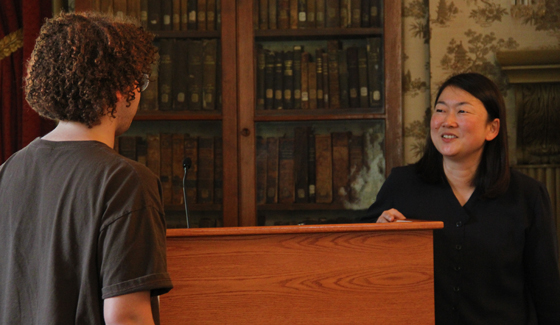

Venture Boldly

 by Stephen Danilovich ‘14
by Stephen Danilovich ‘14
Heroes and idols come and go throughout history, but very few get to be deified. In a Sept. 28 lecture at Knox College, Professor Naoko Shimazu of the University of London recounted the story of a Japanese war hero who became a Shinto deity.
The lecture was the first event this year to be sponsored by the Eleanor Stellyes Center for Global Studies, which brings in guest speakers from around the world to the Knox College campus.
Shimazu (shown above, speaking with a Knox student), an author of several books on Japanese social and cultural issues, is a history professor at Birkbeck College, University of London. Her specialties include modern Japanese history, comparative Asian history, and the history of diplomacy.
The star of Shimazu's lecture was Hirose Takeo, a naval commander in the Russo-Japanese War who was posthumously elevated to become a gunshin, or war god.
In a battle on March 27, 1904, Hirose's ship was hit and started sinking. As the Japanese crew clambered into a raft, Hirose noticed his subordinate Sugino was missing. He stayed behind to search for Sugino, and another volley of shells crashed upon the ship and killed him.
 Hirose was lauded as a model sailor and warrior, and stories about his heroic sacrifice flooded the papers. The Japanese navy gradually released personal information about Hirose, building up popular interest until Hirose's remains -- a bit of his flesh preserved in alcohol -- made it to Japanese shores.
Hirose was lauded as a model sailor and warrior, and stories about his heroic sacrifice flooded the papers. The Japanese navy gradually released personal information about Hirose, building up popular interest until Hirose's remains -- a bit of his flesh preserved in alcohol -- made it to Japanese shores.
The peak of all the hype was a massive naval ceremony held in his honor on April 13, 1904. At the event, Shimazu said, officials unveiled a statue of Hirose and Sugino, which "eternalized the moment." Spotlights from ships illuminated the statue.
In 1935, a shrine was built for Hirose Takeo, elevating him to the status of a Shinto god.
According to Shimazu, the myth didn't emerge as a spontaneous cultural event.
"I believe very strongly that this myth was a (deliberate) creation," she said. "It was created specifically by the navy for a particular purpose."
During this time, the Japanese navy was a secondary branch of the army, and it had been striving for independence for many years. In an effort to become a separate military force, it was dedicated to compiling naval war histories and shaping its public image.
Finding the right material for the creation of a myth meant identifying a hero whose death was spectacular and whose story would capture public interest.
"There was work behind the scenes to gather the necessary information and to create a kind of story that would appeal to the people," Shimazu explained.
Hirose's myth proved to be especially powerful for a couple of reasons, according to Shimazu.
First, it was a modern and appealing take on the traditional Japanese war hero. Hirose's myth revolved around his willingness to sacrifice himself for his lower-ranked brothers-in-arms.
"The navy was running a modern institution," she said. "It encouraged teamwork."
Second, the navy enacted effective strategies to make the myth widely known. The strategies included working with the mass media.
"The navy had managed to galvanize the nation through the help of media," Shimazu said. "The presence of the media was absolutely critical to all of this."
Photos by Supriya Kasaju '12
Published on October 05, 2011